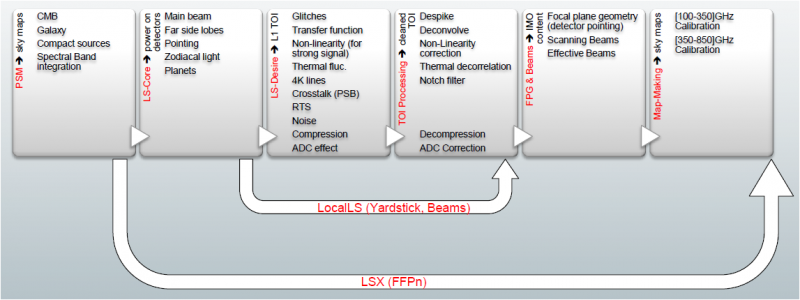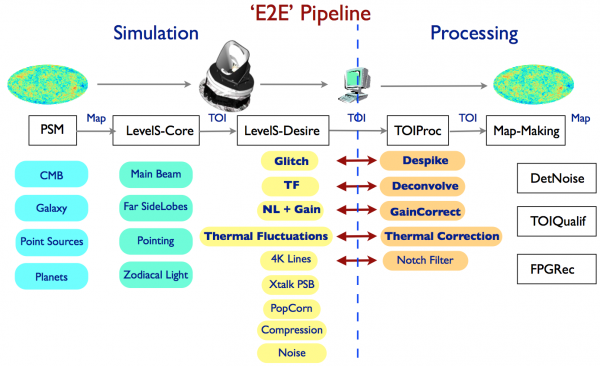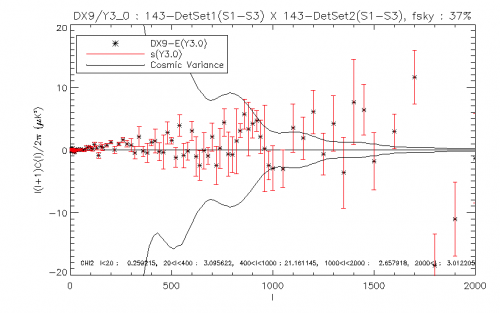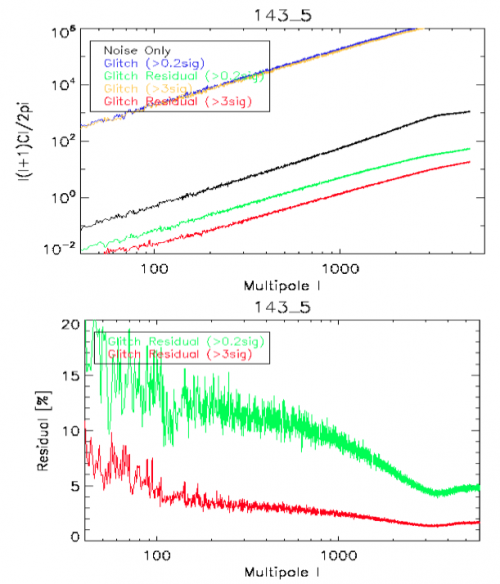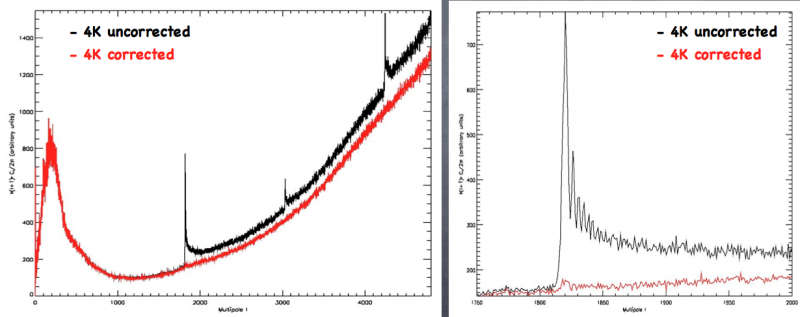Internal overall validation
The HFI validation is mostly modular. That is, each part of the pipeline, be it timeline processing, map-making, or any other, validates the results of its work at each step of the processing, looking specifically for known issues. In addition, we do additional validation with an eye towards overall system integrity by looking at generic differences between sets of maps, in which most problems will become apparent, whether known or not. Both these are described below.
Contents
[hide]Expected systematics and tests (bottom-up approach)[edit]
Like all experiments, Planck/HFI had a number of "issues" which it needed to track and verify were not compromising the data. While these are discussed in appropriate sections, here we gather them together to give brief summaries of the issues and refer the reader to the appropriate section for more details.
- Cosmic Rays - Unprotected by the atmosphere and more sensitive than previous bolometric experiment, HFI was subjected to many more cosmic ray hits than previous experiments. These were detected, the worst parts of the data flagged as unusable, and "tails" were modeled and removed. This is described in the section on glitch statistics and in the section on cosmic rays, as well as in the 2013 HFI Cosmic Ray Removal paper [1].
- Elephants - Cosmic rays also hit the 100 mK stage and cause the temperature to vary, inducing small temperature and thus noise variations in the detectors. These are effectively removed with the rest of the thermal fluctuations, described directly below.
- Thermal Fluctuations - HFI is an extremely stable instrument, but there are small thermal fluctuations. These are discussed in the timeline processing section on thermal decorrelation and in the section on 1.6 K and 4 K thermal fluctuations.
- Popcorn Noise - Some channels were occasionally affected by what seems to be a "split-level" noise, which has been variously called popcorn noise or random telegraphic signal. These data are usually flagged. This is described in the section on noise stationarity and the section on Random Telegraphic Signal Noise
- Jumps - Similar to but distinct from popcorn noise, small jumps were occasionally found in the data streams. These data are usually corrected. This is described in the section on jump corrections.
- 4 K Cooler-Induced EM Noise - The 4 K cooler induced noise in the detectors with very specific frequency signatures, which is filtered. This is described in the 2013 HFI DPC Paper [2], the section below on 4K line residuals, and their stability is discussed in the section on 4K cooler line stability.
- Compression - Onboard compression is used to overcome our telemetry bandwidth limitations. This is explained in [3].
- Noise Correlations - Correlations in noise between detectors seems to be negligble but for two polarization sensitive detectors in the same horn. This is discussed in the 2013 HFI Cosmic Ray Removal paper [1].
- Pointing - The final pointing reconstruction for Planck is near the arcsecond level. This is discussed in the 2013 HFI DPC paper [2].
- Focal Plane Geometry - The relative positions of different horns in the focal plane is reconstructed using planets. This is also discussed in the 2013 HFI DPC paper [2].
- Main Beam - The main beams for HFI are discussed in the 2013 Beams and Transfer function paper [4].
- Ruze Envelope - Random imperfections or dust on the mirrors can increase the size of the beam a bit. This is discussed in the 2013 Beams and Transfer function paper [4].
- Dimpling - The mirror support structure causes a pattern of small imperfections in the beams, which cause small sidelobe responses outside the main beam. This is discussed in the 2013 Beams and Transfer function paper [4]
- Far Sidelobes - Small amounts of light can sometimes hit the detectors from just above the primary or secondary mirrors, or even from reflecting off the baffles. While small, when the Galactic center is in the right position, this can be detected in the highest frequency channels, so this is removed from the data. This is discussed in the 2013 Beams and Transfer function paper [4] and, non-intuitively, the 2013 Zodiacal emission paper [5].
- Planet Fluxes - Comparing the known fluxes of planets with the calibration on the CMB dipole is a useful check of calibration for the CMB channels, and is the primary calibration source for the submillimeter channels. This is done in the 2013 Map-Making and Calibration Paper [6].
- Point Source Fluxes - As with planet fluxes, we also compare fluxes of known, bright point sources with the CMB dipole calibration. This is done in the 2013 Map-Making and Calibration paper [7].
- Time Constants - The HFI bolometers do not react instantaneously to light; there are small time constants, discussed in the 2013 Beams and Transfer function paper [4].
- ADC Correction - The HFI Analog-to-Digital Converters are not perfect, and are not used perfectly. While this is an on-going effort, their effects on the calibration are discussed in the 2013 Map-Making and Calibration paper [7]}}.
- Gain changes with Temperature Changes
- Optical Cross-Talk - This is negligible, as noted in the optical cross-talk note.
- Bandpass - The transmission curves, or "bandpass" has shown up in a number of places. This is discussed in the spectral response paper [4].
- Saturation - While this is mostly an issue only for Jupiter observations, it should be remembered that the HFI detectors cannot observe arbitrarily bright objects. This is discussed in the section below on saturation.
Generic approach to systematics[edit]
While we track and try to limit the individual effects listed above, and we do not believe there are other large effects which might compromise the data, we test this using a suite of general difference tests. As an example, the first and second years of Planck observations used almost exactly the same scanning pattern (they differed by one arc-minute at the Ecliptic plane). By differencing them, the fixed sky signal is almost completely removed, and we are left with only time variable signals, such as any gain variations and, of course, the statistical noise.
In addition, while Planck scans the sky twice a year, during the first six months (or survey) and the second six months (the second survey), the orientations of the scans and optics are actually different. Thus, by forming a difference between these two surveys, in addition to similar sensitivity to the time-variable signals seen in the yearly test, the survey difference also tests our understanding and sensitivity to scan-dependent noise such as time constant and beam asymmetries.
These tests use the Yardstick simulations below and culminate in the "Probabilities to Exceed" tests just after.
HFI simulations[edit]
The 'Yardstick' simulations allows gauging various effects to see whether they need be included in monte-carlo to describe data. It also allows gauging the significance of validation tests on data (e.g. can the value obtained in a difference test can be accounted for by the model?). They are completed by dedicated 'Desire' simulations (Desire stands for DEtector SImulated REsponse), as well as Monte-Carlo simulations of the Beams determination to determine their uncertainty.
Yardstick simulations[edit]
The Yardstick V3.0 characterizes the DX9 data which is the basis of the nominal mission data release. It goes through the following steps:
- The input maps are computed using the Planck Sky Model, taking the RIMO bandpasses as input.
- The LevelS is used to project input maps on timeline using the RIMO (B-Spline) scanning beam and the DX9 pointing. The real pointing is affected by aberration that is corrected by map-making. The Yardstick does not simulate aberration. Finally, the difference between the projected pointing from simulation and from the nominal mission is equal to the aberration.
- The simulated noise timelines, that are added to the projected signal, have the same spectrum (low and high frequency) as the nominal mission noise. For theyardstick V3.0 Althoough detectable, no correlation in time or between detectors have been simulated.
- The simulation map making step use the nominal mission sample flags.
- For the low frequencies (100, 143, 217, 353), the yardstick output are calibrated using the same mechanism (e.g. dipole fitting) as the nominal data reduction. This calibration step is not perfromed for higher frequency (545, 857) which use a differnt principle
- The Official map making is run on those timelines using the same parameters than for real data.
A yardstick production is composed of
- all survey map (1,2 and nominal),
- all detector Detsets (from individual detectors to full channel maps).
The Yardstick V3.0 is based on 5 noise iterations for each map realization.
NB1: the Yardstick product is also the validating set for other implementations which are not using the HFI DPC production codes, an exemple of which are the so-called FFP simulations, where FFP stands for Full Focal Plane and are done in common by HFI & LFI. This is further described in HL-sims
NB2: A dedicated version has been used for Monte-Carlo simulations of the beams determination, or MCB. See Beams#Simulations_and_errors
Desire simulations[edit]
Complementary to the Yardstick simulations, the Desire simulations are used in conjunction with the actual TOI processing, in order to investigate the impact of some systematics. The Desire pipeline allows to simulate the response of the HFI-instrument, including the non-linearity of the bolometers, the time transfer-function of the readout electronic chain, the conversion from power of the sky to ADU signal and the compression of the science data. It also includes various components of the noise like the glitches, the white and colored noise, the one-over-f noise and the RTS noise. Associated to the Planck Sky Model and LevelS tools, the Desire pipeline allows to perform extremely realistic simulations, compatible with the format of the output Planck HFI-data, including Science and House Keeping data. It goes through the following steps (see Fig. Desire End-to-End Simulations) :
- The input maps are computed using the Planck Sky Model, taking the RIMO bandpasses as input;
- The LevelS is used to project input maps into Time ordered Inputs TOIs, as described for the Yardstick simulations;
- The TOIs of the simulated sky are injected into the Desire pipeline to produce TOIs in ADU, after adding instrument systematics and noise components;
- The official TOI processing is applied on simulated data as done on real Planck-HFI TOIs;
- The official map-making is run on those processed timelines using the same parameters as for real data;
This Desire simulation pipeline allows to explore systematics such as 4K lines or Glitches residual after correction by the official TOI processing, as described below.
Simulations versus data[edit]
The significance of various difference tests perfromed on data can be assessed in particular by comparing them with Yardstick realisations.
Yardstick production contains sky (generated with LevelS starting from PSM V1.77) and noise timeline realisations proceeded with the official map making. The final production was regenerated with the same code as the nominal mission in order to get rid of possible differences that might appear for not running the official pipeline in the same conditions.
We compare statistical properties of the cross spectra of null test maps for the 100, 143, 217, 353 GHz channels. Null test maps can either be survey null test or half focal plane null test, each of which having a specific goal :
- survey1-survey2 (S1-S2) aim at isolating transfer function or pointing issues, while
- half focal plane null tests enable to focus on beam issues.
Comparing cross spectra we isolate systematic effects from the noise, and we can check whether they are properly simulated. Spectra are computed with spice masking either nominal mission point sources or simulated point sources, and masking the galactic plane with several mask width, the sky fraction from which spectra are computed are around 30%, 60% and 80%.
The nominal mission data and the Y3.0 realisations are binned. For each bin we compute the statistical parameters (mean and variance) of the Yardstick distribution. The following figure is a typical example of a consistency test, it shows the differences between the Y3.0 mean and the nominal mission, considering the standard deviation of the yardstick. We also indicate chi square values, which are computed within larger bin : [0,20], [20,400], [400,1000][1000,2000], [2000, 3000], using the ratio between (Nominal-Y3.0 mean)2 and Y3.0 variance within each bin. This binned chi-square is only indicative: it may not be always significant, since data variations sometimes disappear as we average them in a bin, the mean is then at the same scale as the yardstick one.
Systematics impact estimates[edit]
Cosmic rays[edit]
We have used Desire simulations to investigate the impact of glitch residuals at 143GHz. We remind that TOIs are highly affected by the impact of cosmic rays inducing glitches on the timelines. While the peak of the glitch signal is flagged and removed from the data, the glitch tail is removed from the signal during the TOI processing. We have quantified the efficiency and the impact of the official TOI processing when removing glitch tails on the scientific signal.
The Glitch model used in this set of simulations has been built using the real data extraction, in order to reproduce the 3 families observed (i.e. long, short and snail) and their relative distribution. This modelling has been validated on 143GHz channels, by comparing the glitch statistics of simulated timelines with real ones. Two types of models have been introduced for these simulations: the first only includes detectable glitches, with a glitch amplitude at the level of at least 3 times the noise level ; the second model also includes undetectable glitches until a level of 0.3 times the noise level.
The input sky used for these end-to-end simulations includes the CMB signal, our Galaxy, the compact sources and the planets. Not any other kind of systematics has been introduced, except the glitches associated with a white and colored noise to reproduce realistic data. For each bolometer three sets of simulated TOIs have been produced: (i) white plus colored noise only, (ii) noise plus "detectable glitches model" and (iii) noise plus "undetectable glitches model". On the simulated TOIs with glitches, two options of the TOI-processing have been used: with or without correction of the glitches (Despike Module), leading to a set of 5 processed TOIs. Maps and power spectra can be built on these sets of data.
It appears that in the case of the "detectable glitch model", the glitch tail residual represents less than 10% of the noise for ell<100 and less than 5% for ell>100. In the case of the "undetectable glitch model", these numbers goes to 20% for ell<100 and 15% for ell>100. Nevertheless the number of undetectable glitches remains largely unknown, and can only be extrapolated from power laws. Hence the results obtained for model 2 including undetectable glitches have to be taken as upper limits of the impact of glitch residuals on the power spectrum. These simulations also show that the glitch tail residuals do not produce any kind of 1/f supplementary noise.
1.6K and 4K stage fluctuations[edit]
The 4K and 1.6K stages are thermally regulated. The level of (controlled) fluctuations is less than 20uK/sqrt(Hz) above the spin frequency (and below 0.2 Hz) for the 4K stage and 10uK/sqrt(Hz) for the the 1.6K stage. Using a typical coupling coefficient of 150 fW/K_4K, this translates into a noise of 3 aW/sqrt(Hz). This is 4% of the bolometer noise variance (with a NEP of typically 15aW/sqrt(Hz)), and is thus negligible.
RTS noise[edit]
The Random Telegraphic Signal (RTS) noise, also called Popcorn Noise, appears as 2-levels jumps added on the baseline signal. Three bolometers are known to be affected by a high-RTS noise: 143-8, 545-3 and 857-4. While the 143-8 and 545-3 detectors are currently excluded from use in any products, other bolometers may show small amounts of small RTS.
We have investigated the probable impact of RTS noise present below the detection limit, i.e. 0.2 times the standard deviation noise of the signal. The Desire simulations with and without RTS noise have been produce on 143GHz bolometers. The analysis performed on the TOIS has shown that the impact measured is in perfect agreement with the expectation derived from the pre-launch RTS report. Residual RTS appears to be strongly limited, with a negligible impact on TOI noise – does not dominate over the 1/f noise at low frequencies (0.01Hz or below), and it would disappear rapidly above 1 Hz, very probably irrelevant at map level.
Baseline jumps[edit]
Similar to but distinct from popcorn noise, small baseline jumps were occasionally found in the data streams. They differ from the RTS noise by a much longer duration of the plateau. These data are usually corrected by subtracting a constant baseline before and after the jumps. About 320 jumps are found per bolometers, this represents 16 jumps per day for hFI, i.e. 12800 over the mission lifetime. While the detection efficiency of the biggest jumps is extremely high, the question of the impact of the jumps with amplitudes lower than 0.5% of the standard deviation of signal is still open. Desire simulations are about to be produced to answer this.
Split-level noise[edit]
The Split-Level noise is the major component of the non-stationnary noise. It appears as a strong increase of the noise level during one or a few rings, and is characterized by the addition of anoher 1/f noise component. The impact of such a systematics effect is under investigation using dedicated Desire simulations at 143GHz.
Pointing-change microphonics[edit]
The "Thruster signal" is not present for all bolometer for 100, 143, 217 GHz. After the peak "Thruster signal", the relaxing time "normal noise" is about the same for all bolometers over channels, i.e. 12 seconds, but amplitude is different. Thus the effect of the manouver has decayed away long before the end of the "unstable" period, which would be minutes after the first thrust.
This effect can be neglected, and does not need to be included in the simulation runs.
Electrical cross-talk[edit]
The Electrical Cross-Talk consists in the electrical contamination received by a given channel and coming from the other channels of the focal plane. This is mainly driven by the locations of the channels inside the electronic devices of the readout chain, and not by their locations in the focal plane.
This effect has been first measured during the ground calibration phase, and then during the inflight 'Calibration, Performance and Validation' phase (CPV Phase) after launch. These two sets of measurements agree to show that the level of electrical cross-talk is smaller than 0.01% for SWBs and 0.1% for PSBs. These estimates have been confirmed by the analysis of the glitches. While the thousands of detected glitches have been flagged for a given channel, the signal of the neighbor channels have been stacked at the same dates of the glitch flags to reveal the amount of electrical contamination coming from the glitched signal. Strong glitches have also been used in the same scope in a second study. These two analysis based on glitches give the same estimates of electrical cross-talk as measured during calibration phases.
Hence the electrical cross-talk has a negligible impact on science data, except probably for PSBs on which further Desire simulations will be carried out.
Optical cross-talk[edit]
It has been shown using planets crossing that the optical cross-talk is negligible, with an upper limit of 0.01%. This effect can be neglected in the total budget error, without any end-to-end simulation.
Time constant[edit]
The impact of the uncertainty of the time response has been studied using a set of 50 Yardstick simulations with CMB only on 8 143GHz bolometers. The set of 50 Time Transfer Function (TF)realizations have been chosen with a Low Frequency Excess Response (LFER) varying within 1.5% around its nominal value. While the same CMB sky map has been convolved through the optical beam, projected into TOIs and convolved with each of the 50 TF realizations, it has then been deconvolved by the nominal TF, leading to the deconvolved TOIs. Maps and power spectra have then been produced using these TOIs and compared to each others.
These simulations have shown that an uncertainty of 1.5% of the LFER yields 1% of error on the power spectrum at all scales, and even less at large scales.
4K line residuals[edit]
The 4K lines are the 4 K cooler induced noise in the detectors with very specific frequency signatures. They are filtered and corrected during the TOI-processing. The efficiency of this correction has been studied using two types of simulations at 143GHz: Yardstick and Desire simulations.
The Yardstick simulations have explored the impact of 4K lines residuals on CMB signal only, by adding a 4K lines pattern on the CMB TOIs, and by applying the same module of correction as used in the TOI-processing. The impact on the CMB power spectrum has been estimated by comparing the spectra obtained on data without 4K lines and data with corrected 4K lines.
The end-to-end Desire simulations include a complete sky (i.e. CMB, Galaxy and point sources) and the complete TOI-processing on the simulated data. The analysis and comparison is then performed on the maps directly and on the power spectra. It has been checked that the 4K lines modeling inputs used in the two sets of simulation are in agreement between them and with in-flight data. Those simulations have been performed on the full 143GHz channel, i.e. 12 detectors, and the full nominal mission range.
Both analysis converge to show that the 4K lines residual represent 2% to 2.5% maximum of the noise level at particular ell values affected by the 4K lines (such as ell=1800). These residuals are well below the one-sigma discrepancy of the noise itself at the same particular ell values.
Hence the 4K lines residuals are negligible. Nevertheless, the correlation between the 4K lines and the ADC correction discussed in [2]Planck-2013-VI may have an impact on the gain variation estimates at the end of the processing. This has still to be quantified.
Saturation[edit]
The Planck-HFI signal is converted into digital signal (Raw-Signal) by a 16 bit ADC. This signal is expressed in ADU, from 1 to 65535, and centered around 32768. A full saturation of the ADC corresponds to the value of 1310680 ADU, corresponding to the number of samples per half period times, N_sample, times 2^15. Nevertheless, the saturation of the ADC starts to appear when a fraction of the raw signal hits the 32767 (2^15) value.
We have used the SEB tool (standing for Simulation of Electronics and Bolometer) to simulate the response of the Readout Electronics Chain at a very high sampling, to mimic the high frequency behavior of the chain and investigate sub-period effects. It has been shown by this kind of simulations that the saturation of the ADC starts to appear if the signal is more then 7*10^5 - 8*10^5 ADU. Hence the variation of the gain, due to the saturation of the ADC, has an impact only when crossing Jupiter for SWB353GHz and SWB857GHz bolometers. This effect can be neglected.
References[edit]
- ↑ Jump up to: 1.01.1 Planck 2013 results: HFI energetic particle effects, Planck Collaboration 2013 X, A&A, in press, (2014).
- ↑ Jump up to: 2.02.12.22.3 Planck 2013 results: High Frequency Instrument Data Processing, Planck Collaboration 2013 VI, A&A, in press, (2014).
- Jump up ↑ Planck early results, IV. First assessment of the High Frequency Instrument in-flight performance, Planck HFI Core Team, A&A, 536, A4, (2011).
- ↑ Jump up to: 4.04.14.24.34.44.5 Planck 2013 results: HFI spectral response, Planck Collaboration 2013 IX, A&A, in press, (2014).
- Jump up ↑ \textit{Planck} 2013 results: Zodiacal emission, Planck Collaboration XIV, A&A, in press, (2014).
- Jump up ↑ Planck 2013 results: HFI calibration and Map-making, Planck Collaboration 2013 VIII, A&A, in press, (2014).
- ↑ Jump up to: 7.07.1 Planck 2013 results: HFI time response and beams, Planck Collaboration 2013 VII, A&A, in press, (2014).
(Planck) High Frequency Instrument
Cosmic Microwave background
[LFI meaning]: absolute calibration refers to the 0th order calibration for each channel, 1 single number, while the relative calibration refers to the component of the calibration that varies pointing period by pointing period.
analog to digital converter
Data Processing Center
(Planck) Low Frequency Instrument
random telegraphic signal
EMI/EMC influence of the 4K cooler mechanical motion on the bolometer readout electronics.
Planck Sky Model
Noise Equivalent Power
Calibration and Performance Verification
low frequency excess response
